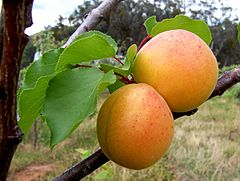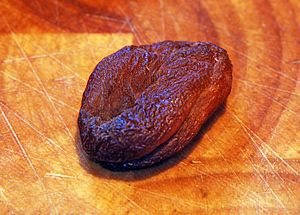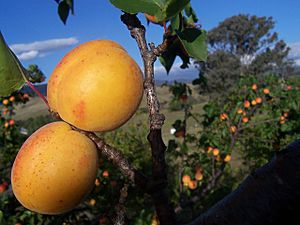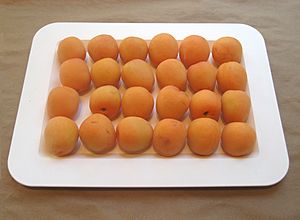Apricot facts for kids
Quick facts for kids Apricot |
|
|---|---|
 |
|
| Apricot fruit | |
| Scientific classification | |
| Kingdom: | |
| Division: | |
| Class: |
Magnopsida
|
| Order: | |
| Family: | |
| Genus: | |
| Subgenus: | |
| Section: |
Armeniaca
|
| Species: |
P. armeniaca
|
| Binomial name | |
| Prunus armeniaca |
|
The apricot is a sweet and juicy fruit that looks a bit like a small peach. It's known for its soft, fuzzy skin and a single large seed inside. Apricots are part of the Prunus family, which also includes plums, cherries, and peaches.
Contents
What is an Apricot?
Apricots are a type of fruit called a drupe. This means they have a fleshy outside that surrounds a hard shell, which then holds a single seed. Think of a peach or a plum – they are also drupes!
The Apricot Tree
- Tree: Apricot trees are usually small to medium-sized. They can grow about 8 to 12 meters (26 to 39 feet) tall. Their branches spread out, forming a thick, leafy top called a canopy.
- Leaves: The leaves of an apricot tree are shaped a bit like a heart. They have pointed tips and are about 8 centimeters (3 inches) wide.
- Flowers: Before the fruit appears, apricot trees bloom with beautiful flowers. These flowers can be white or have a pinkish color.
- Fruit: The apricot fruit itself is usually yellow or orange. Sometimes, it might have a reddish blush. Its skin is smooth and has very tiny hairs, making it feel almost hairless. Inside, there's just one large seed.
Growing Apricots
Apricot trees originally come from places with cold winters. However, they can also grow well in areas with a Mediterranean climate, like California or parts of Europe. This is because they need some cool winter weather to rest and get ready for spring. The dry weather in these areas is also great for the fruit to ripen.
Winter Weather and Frost
Apricot trees are quite strong and can handle cold winter temperatures, even as low as -30 °C (-22 °F). They are a bit tougher than peach trees. However, a big problem for apricot growers is spring frosts. Apricot trees tend to flower very early in the spring. If a frost happens after the flowers appear, it can kill them, meaning no fruit for that year.
The trees are also sensitive to big changes in temperature during winter. In their native China, winters are very cold but the temperature stays more steady. In places like Europe and North America, the temperature can go up and down a lot, which can stress the trees.
Special Growing Methods
To help apricot trees grow better, especially in different climates, farmers often use a method called grafting. This is when a part of one plant (the scion, which is the apricot branch that will produce fruit) is joined to another plant (the rootstock, which is the root system of a plum or peach tree). The rootstock helps the apricot tree grow strong roots and adapt to different soils or climates, while the scion gives us the delicious apricot fruit.
Apricot Hybrids
Did you know that apricots can be crossed with plums? When this happens, they create new fruits with fun names like plumcots, apriplums, pluots, or apriums! These fruits have a mix of flavors and textures from both apricots and plums.
Dried Apricots

Dried apricots are a popular snack and a traditional dried fruit. Turkey is the biggest producer of dried apricots in the world.
When apricots are dried, they are sometimes treated with something called sulfur dioxide. This helps them keep their bright orange color. If they are not treated, like organic dried apricots, they will be darker and have a slightly different texture.
Dried apricots are packed with nutrients! When the water is removed, the good stuff like vitamin A, vitamin E, potassium, and iron becomes more concentrated. This makes them a very healthy snack.
See also
 In Spanish: Albaricoque para niños
In Spanish: Albaricoque para niños
Images for kids
-
Preparing apricots in the grounds of Alchi Monastery, Ladakh, India
-
David Packard's apricot orchard in Los Altos Hills, preserved by the David and Lucile Packard Foundation, is one of the few remaining in Santa Clara County, where apricots were a major crop before the urban sprawl of Silicon Valley.
-
Drying apricot fruits (Fergana, Uzbekistan)
-
Dried date, peach, apricot, and stones. From Lahun, Fayum, Egypt. Late Middle Kingdom. The Petrie Museum of Egyptian Archaeology, London
-
Prunus sibirica (Siberian apricot; hardy to −50 °C (−58 °F) but with less palatable fruit)
-
Apricot tree, Turkey
-
Apricots drying on the ground in Cappadocia
-
Packaging apricot fruits in Uzbekistan
















